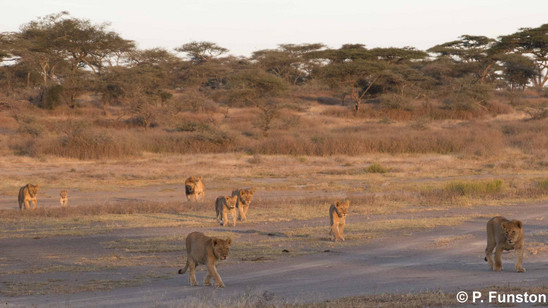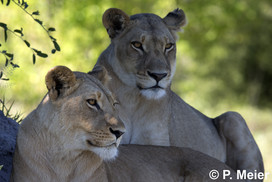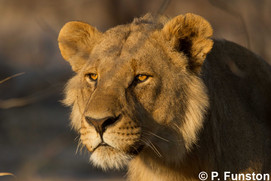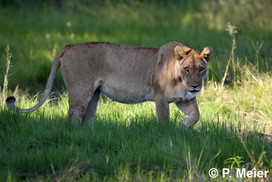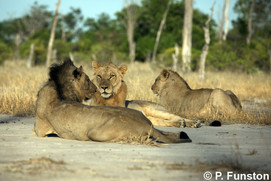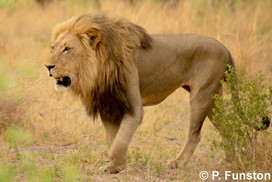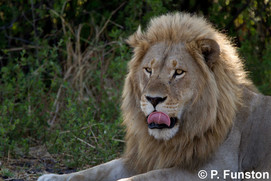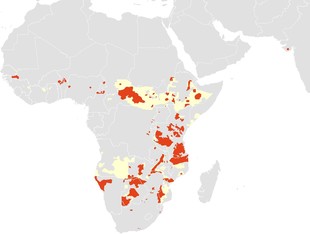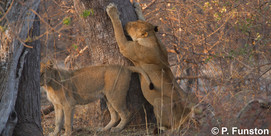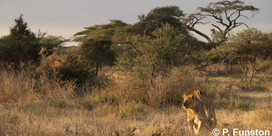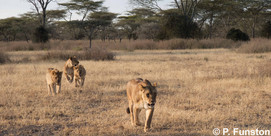African lion
Panthera leo
IUCN Red List: Vulnerable
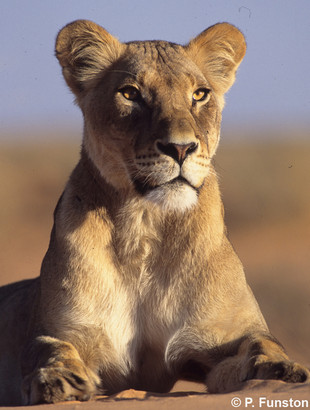
| Weight: | 110-272 kg |
| Body length: | 137-250 cm |
| Tail length: | 60-100 cm |
| Longevity: | 12-16 years |
| Litter size: | 1-4 cubs |
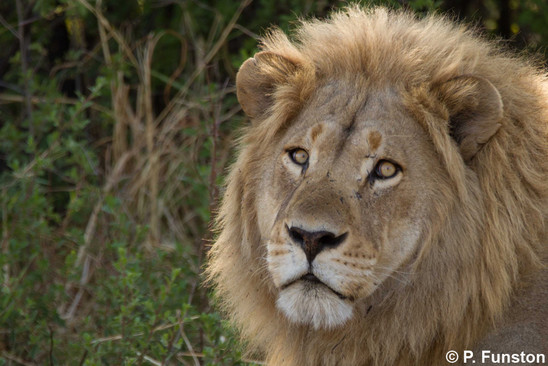
Description
Previously eleven lion subspecies were described. Afterwards the lion was divided into two subspecies: the African lion (Panthera leo leo) and the Asiatic lion (Panthera leo persica). However, more recent studies indicate that lions from Asia and West and Central Africa are more closely related to each other than to lions from Eastern and Southern Africa. These two main divisions of lions are not homogeneous as there is genetic subdivision within each, with more genetic variation and deeper divergences within the Eastern and Southern branch than within the Asian plus West and Central African one. Based on these recent genetic studies, two subspecies of the lion are recognised:
- Panthera leo leo in Central and West Africa and India, formerly throughout North Africa, South-East Europe, the Middle East, Arabian Peninsula and South-West Asia
- Panthera leo melanochaita in southern and eastern Africa.
The contact zone between the two subspecies lies somewhere in Ethiopia.
The lion is very muscular and its body is designed for strength and short burst of high speed. The shoulders and forepaws are particularly massively and powerful enabling lions to tackle and subdue large prey. The lion has a uniformly tawny coat, which blends into the grass cover in savanna. There is some local variation in coat colour from pale yellowish or tawny to light grey. Leucism, which is white fur but with pigmented eyes and skin, has been reported only from the vicinity of Timbavati in the Kruger National Park, South Africa. Melanistic lions have not been recorded. Male lions have tufted tails and manes, which vary from quite sparse fur in hot and humid areas to very impressive manes in milder climates. The mane's functions to attract females for mating serving as an indicator of individual fitness. Young lions have pink noses that become progressively speckled with black spots as they mature. By five or six years of age about sixty percent of the nose is black, becoming solidly black in some older individuals. This change in nose colour typically coincides with male lion's manes becoming darker and more complete at about five to six years of age. African lions have shorter fur and a more pronounced tail tassel than Asiatic lions, which in turn have a more pronounced belly (lingual) fold of skin. The belly fold is also seen in lions from West Africa.
Language/Country | Name |
|---|---|
Botswana (Ju/hoan Bushman; Setswana) | N!hai; tau |
Ethiopia (Amharic) | ambessa |
French | lion d'Afrique |
German | Löwe |
Hausa | zaki |
Kenya (Kikuyu; Luo; Massai) | ngatia muruthi; labwor; olugatany |
Kiswahili | simba |
Malawi (Chichewa) | nkharam |
Namibia (Damara) | xamm |
Nepal | hiun chituwa |
Nigeria (Ibo; Yoruba) | odum; aja |
Portugese | leao |
Somalia | ibaax, gool, davar |
Spanish | león |
Tanzania (Samburu) | olugatany |
Uganda (Luo) | labwor |
West Africa (Lingala) | ngouambulu |
Status and Distribution
The African lion is classified as Vulnerable in the IUCN Red List. In South Africa the lion is listed as Least Concern but as Critically Endangered in West Africa. In parts of the lion's range, its current status is not well known, with key knowledge gaps in Angola, Central African Republic and South Sudan. Populations there are supposed to be highly declining.
To estimate lion populations is a challenging and difficult task. Lions exist at low densities, have very large home ranges and can be quite shy, which makes them difficult to count. Additionally, individual recognition is not as easy in other large cats. In the early 2000's, several initiatives tried to estimate the total number of wild lions in Africa. These were based on a compilation of recent estimates from scientific surveys, expert opinions and best guesses. Two independent initiatives determined the African lion population to be 22,800 to 39,000 individuals. The most recent estimate is about 35,000 lions in less than 20% of their former range, made by reviewing all available data and combining it with satellite imagery. As many important lion populations have never been properly surveyed, and given the rates of decline in surveyed populations, the actual number of wild lions may be closer to 20,000 than to 30,000.
In West Africa the lion subpopulation is only estimated at around 400 individuals with a continuous decline and to be isolated from the populations in Central Africa. The lion is regionally extinct in Côte d'Ivoire, Gambia, Guinea-Bissau, Mali, Mauritania, Sierra Leone and Togo and possibly extinct in Ghana and Guinea.
Population estimates | Chardonnet, 2002 | Bauer & Van Der Merwe, 2004 | Riggio et al. 2013 |
|---|---|---|---|
Southern Africa | 10,000 | 19,651 | 12,081 |
Eastern Africa | 11,000 | 15,744 | 19,927 |
West Africa | 850 | 1,163 | 480 |
Central Africa | 950 | 2,815 | 2,419 |
Total | 22,800 | 39,373 | 34,907 |
More than half of the remaining lions in Africa reside in only 11 key populations contained within protected areas. Although some of these in southern Africa are stable or increasing, some key populations are nevertheless declining. Rates of decline are extremely high in West Africa with an estimated 80% decline over the last 20 years and about a 50% decline in East Africa over the same time period, whereas lion populations in Southern Africa are increasing or stable. The whole lion population is inferred to have declined by approximately 42% over the past 21 years. Throughout most of Africa, lions are becoming increasingly rare outside protected areas and a lot of lions live in isolated and small populations. The situation of the African lion is most alarming in West and Central Africa, which contain less than 10% of the total African lion population. In western Africa, lions are critically endangered, being confirmed in only four protected areas with only about 500 lions remaining and occupying one percent of its historical range. Currently African lions are largely limited to savannah habitats.
Historically, lions were widely distributed and occurred in Africa, Europe, Middle East and in Southwest Asia. Lions disappeared from Europe during the first century AD and from North Africa, the Middle East and most parts of Asia between 1800 and 1950. In Asia a small population of lions occurs in the Gir Forest area. In West Africa they may have already lost almost 99% of their former range in this region.
Habitat
The African lion occurs south of the Sahara. It has a high habitat tolerance and inhabits different environments such as forested areas, dry forests, bushlands and deserts, but is largely a species of the savannas. Lions have been recorded at elevations of up to 4,240 m in the Bale Mountains in Ethiopia and up to 3,600 m on Mountain Elgon in Kenya. The lion has a preference for open areas such as scrub and grass complexes, and open to closed woodland, and requires areas with sufficient shelter and cover for hunting and denning, sufficient suitable prey and minimal disturbance from humans.
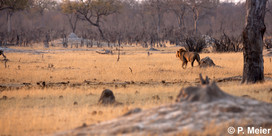
- Lion in Hwange National Park, Zimbabwe
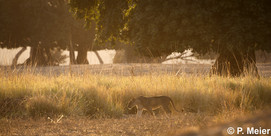
- Lion habitat in Mana Pools National Park, Zimbabwe
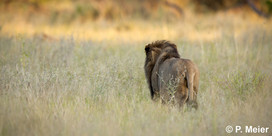
- Lion in Kwara, Nigeria
Ecology and Behaviour
The lion is mainly nocturnal and crepuscular killing over 95% of its prey at night. Lions spend large parts of the day and night resting and are typically active for four to six hours per day. The lion is the most social of all cat species, living in complex social systems called prides and exhibiting group territorial behaviour. Females engage in several cooperative behaviours unique among felids. Pride members often give birth in synchrony and the young are reared communally. There seems to be a complex division of labour among hunting lionesses. The pride structure varies between African and Asian lion populations and may even differ locally depending on climate and prey base conditions. The average size of lion prides is four to six adult lionesses but can range from 1-21. This is the core and most stable unit in the pride. Prides are typically defended by coalitions of two males, range 1-9, and typically have a number of dependent cubs or subadults. Thus prides typically average about 12-16 individuals. In areas with high human hunting pressure and reduced prey base, pride sizes tend to be smaller, cub survival lower and pride persistence is less secure.
Related or unrelated males form coalitions to compete for tenure in a pride, which typically lasts for one breeding cycle, about 24-36 months. A single male or a male coalition holds tenure over one or more prides. Single males seldom maintain tenure over prides except in low-density lion populations, as competition for pride tenure is very high. Only very large coalitions, typically 3-5 individuals, tend to regularly have tenure over multiple prides, although paired coalitions often take over tenure of an adjacent pride once the cubs in their current pride are over 18 months old. When a pride is taken over by new males, infanticide is common if there are young cubs (less than 12 months old). Typically then most females lose their cubs within a period of about a month. In this way males assure their own paternity and lionesses come into oestrous quite soon after the take over.
The size of the pride and its territory is strongly influenced by prey base. In high-density lion populations, density may range from >10-40 lions per 100 km², with territories ranging from about 50-200 km². Such high densities are only possible in areas of high prey biomass, typically with resident prey and no limitation of other key resources. Moderate density lion populations, ranging from 4 to <10 lions/100 km² occur in areas of moderate prey biomass, which often include nutrient poor woodlands with limited water resources and thus support lower prey densities. In these areas pride ranges typically cover >200-500 km². When prey is far less abundant, typically limited by low rainfall or very poor soils, low density lion populations occur at densities of 1-3 lions per 100 km², with home ranges increasing exponentially in size from >500 to up to about 5000 km². Lions occupying larger home ranges than this are probably not resident and may wander widely before settling down in a territory.
Lions are conspicuously territorial and both sexes defend the territory against same sex intruders. While male lions holding a territory scent mark and roar very frequently to demarcate and announce their presence, lionesses seldom do so when they have young cubs, other than in the presence of the pride male. Lionesses start to scent mark more frequently when their cubs are about 30 months old or have dispersed. The lions roar can be heard by other lions for about 5-10 kilometres and serves to warn other males not to enter their territory, to assure their pride that they are still defending the territory, and to allow subadult lions to avoid them.
Lions drink regularly when water is available but are also capable of obtaining most of their moisture requirements from their prey and even from plants. This allows lions to survive in very dry environments and go for very long periods without drinking water. However, waterpoints play a pivotal role in the movements and hunting behaviour of lions in most environments. Lions thus spend a far greater amount of time close to water than further away and in many environments make most of their kills within about two kilometres of a waterhole or riverbank.
Lions are not seasonal breeders having cubs at any time of the year. In some ecosystems, cub survival can be influenced by either seasonal or cyclical climatic events. When conditions are suitable, lion populations can respond quickly to excess prey, and prides can increase quickly in size, typically also shrinking the home range, allowing new prides to establish. The onset of spermatogenesis begins at 30 months, but, although sexually mature, few male lions can hold a territory, and thus breed successfully, before about five years of age. Females may begin mating at 24 months but successful reproduction generally occurs when lionesses are older than three years of age. Typically oestrus lasts for 4 days and the inter-oestrus interval may be as short as 16 days. The gestation period lasts 100 -114 days. The mortality of cubs is rather high in populations that experience extended periods of prey scarcity, but is quite low in populations with moderate to high resident prey densities. Cub survival is lower in prides with three or less lionesses and in prides of more than seven lionesses. In the former, territorial skirmishes often result in cub mortality, and in large prides, within pride competition often results in the death or starvation of cubs.
The interbirth interval varies largely according to survival of cubs and the particular environment. When cubs survive, the interbirth interval is typically about two to three years, with longer interbirth intervals in ecosystems with relatively high resident prey biomass and thus high lion densities. Males generally leave their natal pride willingly at 3-4 years but young males may be forced out much earlier by a pride takeover. Male lions that disperse from their natal pride at less than 30 months of age seldom survive, often being killed in retaliation for livestock depredation. Most young females are incorporated into their natal prides, but about 30% disperse at approximately 2.5 years. Females can reproduce up to the age of about 12-13 years. Although male lions of up to 16 years old can still produce viable sperm, very few males above 10-11 years old can maintain a territory, often dying quite soon after finally becoming loners without a pride or coalition partner.
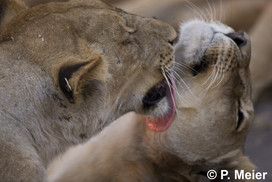
- Two female lions cleaning each other, Linyanti, Botswana.
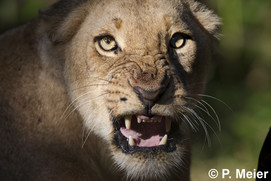
- Female lion, Mana Pools, Zimbabwe.
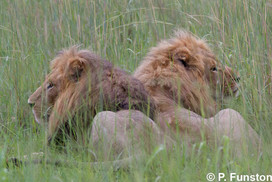
- Two male lions resting.
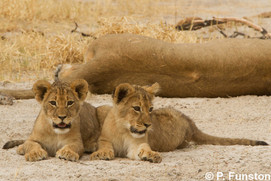
- Two lion cubs.
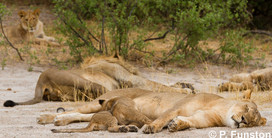
- Lion pride resting.
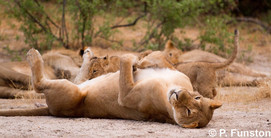
- Female lion with its cubs.
Prey
The lion is a generalist hunter and will take almost any animal, but they have a marked preference for medium to large sized ungulates (100-300 kg) such as wildebeest, zebra, buffalo, giraffe, kudu and waterbuck. They also catch smaller antelopes such as gazelles and impala quite frequently and only prey on the lost or weakened young, or severely weakened adults, of very large prey such as rhinos, hippos and particularly elephants. Although they will go for long periods and ignore easy temptations, at times lions also kill unattended livestock, and much more rarely even humans. Lions also frequently steal the kills made by other carnivores and will scavenge from any carcass they find. Lions hunt mostly at night and in groups but have a relatively low hunting success rate with about 30% of attempts being successful. Although it is widely believed that lionesses do most of the hunting, when on their own, male lions are efficient hunters typically tackling large prey such as buffalo and giraffe. Male lions have also been found to prey successfully on warthogs by digging them out of their burrows, and on impala, particularly when hunting in thick bush. Lionesses prefer hunting medium-large ungulates such as wildebeest and zebra in more open areas where their co-ordinated hunting strategy is most effective.
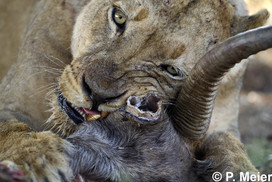
- Female lion with its prey, Zimbabwe.
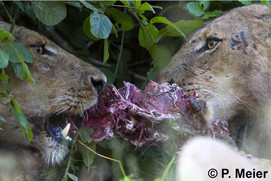
- Female lions with their prey, Mana pools, Zimabwe.
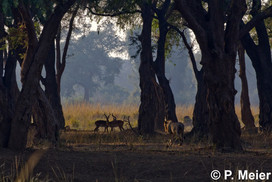
- Lion and its prey species, Zimbabwe.
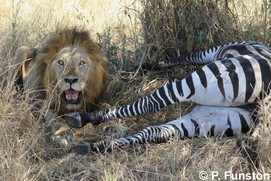
- Male lion with hunted zebra.
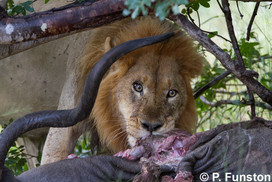
- Male lion feeding on an antelope.
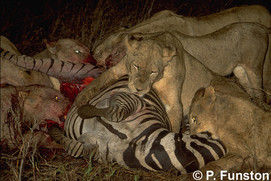
- Lions feeding on their prey a zebra.
Main Threats
The main threats to lions include retaliatory or indiscriminate killing (using spears, guns and poisoning), prey base depletion, bushmeat poaching and excessive or poorly monitored trophy hunting. Occasional livestock predation and rare attacks on humans cause intense human-lion conflict which has, over the last three decades, increased dramatically in conjunction with rising human populations.This is steadily extirpating lions out of many areas lacking formal protection where humans reside. It is not very well known how many lions are killed as problem animals by local people, although that this is the major threat to lions outside of protected areas. Lions are very vulnerable to being killed in wire snares and gin traps set for large ungulates. In some areas, this has the greatest impact on lion populations, and often occurs deep into large protected areas. The bushmeat trade is a way underappreciated contributor to lion population declines and vast areas of suitable habitat are now completely devoid of prey, with lions from those areas either having been caught in snares or killed when resorting to hunting livestock. Herbivore population size’s increased by 24% in Southern Africa but declined by 52% in Eastern and by 85% in West Africa.
Trophy hunting is taking place in various countries in sub-Saharan Africa. Such hunting can be considered an important conservation tool providing it is done sustainably and that money is directed to the communities that have to live with the lions. However, in all the key lion hunting countries in Africa, this is not the case: communities see very little benefit from living with lions and benefits from lion hunts are not directed to the communities. Some countries are starting to address this largely through limiting offtakes by instituting age-based regulations, the theory being that by only hunting lions over six years of age that this should be sustainable. Thus lions continue to be excessively killed both legally for trophies and illegally for retribution, cultural purposes and in traps set for their prey.
At times, diseases such as rabies or canine distemper virus can also be a problem in some parts of their range, but generally diseases do not largely affect lion populations. The small size of many lion populations’ makes them particularly vulnerable to all of the threats listed above and as lions scavenge frequently they are very vulnerable to poisoned carcasses.
The above threats are typically underpinned by inadequate management budgets to adequately safeguard protected populations. However, the ultimate factor influencing lion populations is increasing human population, which leads to all of the above, eventually resulting in habitat fragmentation, suppressed and small lion populations exposed to continuous human pressure. In the meantime, a lot of research is being done to find strategies whereby lions can co-exist with humans, even if this is only around the borders of larger protected areas. However, some scientists increasingly believe that the future for lions in Africa exists mainly in very large protected areas, and that smaller reserves will only be able to conserve lions if they are adequately fenced off from human activities.
In West Africa lions are largely restricted to within protected areas. These protected areas have a weak management leading to the decrease of prey populations and the persecution of lions also inside the protected areas. Further deterioration of the last protected areas containing lions in West Africa can lead to their local extinction.
The latest threat to lions is the rising demand by traditional Asian medicine. As wild living tiger populations are declining, the illegal trade for bones and body parts is shifting to lions as an alternative.
Conservation Efforts and Protection Status
The lion is protected under Appendix II of CITES. Hunting is prohibited in Angola, Botswana, Congo, Gabon, Ghana, Malawi, Mauritania, Niger, Nigeria and Rwanda. Hunting is regulated or restricted to problem animals in Benin, Burkina Faso, Central African Republic, Ethiopia, Ivory Coast, Kenya, Mali, Mozambique, Senegal, Somalia, Sudan, Tanzania, Togo, Uganda, Zaïre, Zambia and Zimbabwe. Trophy hunting is permitted in Benin, Burkina Faso, Cameroon, CAR, Mozambique, Namibia, South Africa, Tanzania, Zambia and Zimbabwe and there is no legal protection of the lion in Burundi, Guinea Bissau, Lesotho, Namibia, South Africa and Swaziland. No information is available for Chad, Djibouti and Guinea.
To minimize human-lion conflict, appropriate livestock management measures must be taken, measures for problem animal control and mechanisms for compensating livestock losses.
In Sub-Saharan Africa, the lion conservation community works in four broad regions: West, Central, East and South. Several workshops for the conservation of lions have been conducted throughout Africa in recent years. Regional Conservation strategies have been developed for West and Central as well as for Eastern and Southern Africa. The African lion conservation strategy in West and Central Africa has three main objectives:
- to reduce lion-human conflict
- to conserve habitat and wild prey base
- to increase lion habitat and wild prey base
The lion conservation strategy of Eastern and Southern Africa additionally includes policy and land use aspects as well as socio-economic issues, trade and conservation politics. Both strategies have set priorities for lion conservation including the improvement of lion management and the creation of incentive through benefits for communities living with lions. These regional strategies are thought to help guide Action plans and conservation projects for lions and have the potential for broad and significant improvement of the lion status.
